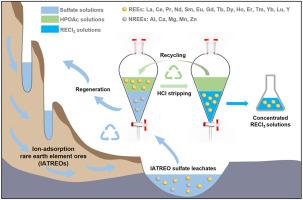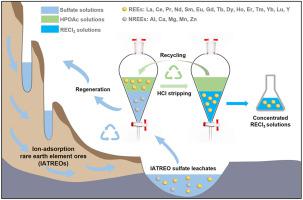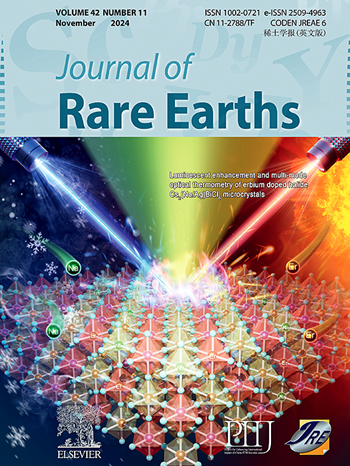Efficient enrichment and selective recovery of rare earths from sulfate leachate of ion-adsorption type rare earth ore by extraction with HPOAc
IF 7.2
1区 化学
Q1 CHEMISTRY, APPLIED
引用次数: 0
Abstract
The efficient enrichment and separation of rare earth elements (REEs) from sulfate leachates of ion-adsorption type rare earth ore (IATREO) is still a challenge. This work presents a novel extractant 2-(bis((2-ethylhexyl)oxy)phosphoryl)-2-hydroxyacetic acid (HPOAc) for the selective extraction and efficient enrichment of REEs from sulfate leachates of IATREO. HPOAc exhibits higher extraction ability for all fifteen REEs(III) than naphthenic acid (NA) at pHini = 1.56. Furthermore, it has no drawbacks of di-(2-ethylhexyl) phosphoric acid (P204) and 2-ethylhexyl phosphoric acid mono-2-ethylhexylester (P507) such as weak extraction ability towards light REEs(III) and high stripping acidity for heavy REEs(III). It has better separation performance for metal ion impurities than P204 and P507, especially for the typical impurity Al(III). Furthermore, the HPOAc system has better phase separation behavior and extraction phenomena. A simulated operation with two-stage counter-current extraction and single-stage stripping of REEs was carried out using unsaponified HPOAc. The recovery of REEs reaches 98.7%. The concentration of REEs increases from 0.44 to 130.35 g/L, indicating a nearly 300-fold increase. Furthermore, the content of REEs increases from 77.8 wt% to 97.6 wt%. So HPOAc has the potential to selectively recover REEs from sulfate leachates of IATREO.


用 HPOAc 萃取从离子吸附型稀土矿硫酸盐浸出液中高效富集和选择性回收稀土
从离子吸附型稀土矿(IATREO)硫酸盐浸出液中高效富集和分离稀土元素(REEs)仍是一项挑战。本研究提出了一种新型萃取剂 2-(双((2-乙基己基)氧基)磷酰)-2-羟基乙酸(HPOAc),用于从离子吸附型稀土矿硫酸盐浸出液中选择性萃取和高效富集稀土元素。在 pHini = 1.56 的条件下,HPOAc 对所有 15 种 REEs(III)的萃取能力均高于环烷酸(NA)。此外,它没有二(2-乙基己基)磷酸(P204)和 2-乙基己基磷酸单-2-乙基己酯(P507)的缺点,如对轻型 REEs(III)的萃取能力弱,对重型 REEs(III)的汽提酸度高。与 P204 和 P507 相比,它对金属离子杂质具有更好的分离性能,尤其是对典型杂质 Al(III)。此外,HPOAc 系统还具有更好的相分离行为和萃取现象。使用未皂化的 HPOAc 进行了两级逆流萃取和一级 REEs 汽提的模拟操作。REEs 的回收率达到 98.7%。REEs 的浓度从 0.44 g/L 增加到 130.35 g/L,增加了近 300 倍。此外,REEs 的含量也从 77.8 wt% 增加到 97.6 wt%。因此,HPOAc 具有从 IATREO 的硫酸盐浸出液中选择性回收 REEs 的潜力。
本文章由计算机程序翻译,如有差异,请以英文原文为准。
求助全文
约1分钟内获得全文
求助全文
来源期刊

Journal of Rare Earths
化学-应用化学
CiteScore
8.70
自引率
14.30%
发文量
374
审稿时长
1.7 months
期刊介绍:
The Journal of Rare Earths reports studies on the 17 rare earth elements. It is a unique English-language learned journal that publishes works on various aspects of basic theory and applied science in the field of rare earths (RE). The journal accepts original high-quality original research papers and review articles with inventive content, and complete experimental data. It represents high academic standards and new progress in the RE field. Due to the advantage of abundant RE resources of China, the research on RE develops very actively, and papers on the latest progress in this field emerge every year. It is not only an important resource in which technicians publish and obtain their latest research results on RE, but also an important way of reflecting the updated progress in RE research field.
The Journal of Rare Earths covers all research and application of RE rare earths including spectroscopy, luminescence and phosphors, rare earth catalysis, magnetism and magnetic materials, advanced rare earth materials, RE chemistry & hydrometallurgy, RE metallography & pyrometallurgy, RE new materials, RE solid state physics & solid state chemistry, rare earth applications, RE analysis & test, RE geology & ore dressing, etc.
 求助内容:
求助内容: 应助结果提醒方式:
应助结果提醒方式:


